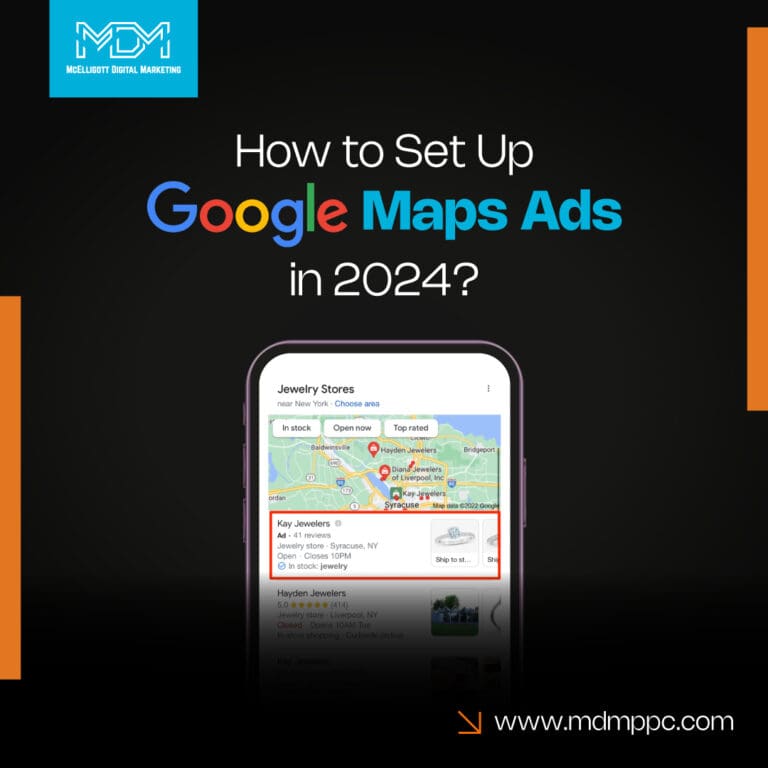If you’re looking for how to run Google Maps ads to attract local customers, you’re just at the right place. Google Maps local search ads are a powerful way to make it easy for customers to get to your shop or local store.
Google Maps ads are a great way for businesses to reach potential customers actively looking for what they offer, right when they need it. Just like search results, Google Maps is a digital marketing platform for local business owners who are looking for nearby customers.
If you advertise on Google Maps, you can:
- show your business’s location on a map, along with its address and phone number.
- boost your business visibility and attract potential customers in your vicinity.
- highlight location-specific benefits, promotions, or events.
- get your customers to call you directly from the search results.
- drive website traffic.
In this blog article, you’ll learn about the benefits of Google Maps ads and how to advertise on Google Maps. Let’s get started.
What are Google Maps ads?
Google Maps Ads are a powerful advertising feature offered by Google that allows businesses to promote their products and services directly within the Google Maps platform. These ads are designed to reach users who are actively searching for local businesses, services, or products in a specific geographic location.
Google Maps Ads seamlessly integrate into the Google Maps app and desktop interface. When users perform relevant searches, such as “restaurants near me” or “electronic stores in Missouri,” sponsored pins or logos from businesses appear on the map, providing users with additional information.
Businesses can significantly increase their visibility to local audiences with the help of a local search marketing agency. These ads allow businesses to stand out, making it easier for potential customers to discover their products or services.
One of the key advantages of Google Maps Ads is the ability to target users based on their geographic location. Advertisers can define specific regions, neighborhoods, or radiuses where they want their ads to appear, ensuring they reach the most relevant local audience.
Google Map Pack Ads
The Map Pack, a set of local business listings displayed prominently in search results, is a prime space for advertising. You can optimize your business profile and bid strategically to secure a spot in the Map Pack, enhancing your business’ visibility and attracting more customers.
How do Google Maps ads work?
Businesses can make the most out of Google Maps by using it as a tool to get noticed. Imagine someone needs an electronic nearby. They can simply pull out their phone, use Google Maps, type “electronic store near me,” and there – a list of nearby options pops up within a minute. The higher up your business appears in these map search results, the more likely people will see it instead of your competitors.
But what if you want your business to stand out in all relevant searches?
This is where Google Maps ads step in.
Instead of sending users to a website that anyone in the world can see, Google Maps ads highlight your business to people who are either right around the corner or actively searching in the area.
According to Wordlead, map advertising gets about 50% more people to notice and check out your business compared to regular online searches. You should focus on local advertising because about 36% of searches are based on where someone is.
Half of the clicks on these paid ads come from people using their phones. When someone is searching or checking out ads on their phone, about 9 out of 10 times, they’ll click on the first set of results they see, says Truelist. So, if your ad is at the top, mobile users are more likely to click on it.
Google Maps ads put a spotlight on your business for people close by. Paying a bit for these ads can help you get noticed more, especially by people using their phones to find what they need.
Why advertise on Google Maps?
Here are the benefits of advertising your business on Google Maps:
- Local targeting
Google Maps Ads enables businesses to target a local audience with precision. By promoting your products or services to users nearby, you tap into the immediate needs and preferences of local customers.
This hyper-local targeting increases the relevance of your ads, leading to higher engagement and conversion rates.
- Increased visibility
Advertising on Google Maps enhances your business’s visibility, especially in a crowded local market. When users search for relevant products or services in their area, your ad can appear prominently, ensuring that your business stands out and captures the attention of potential customers.
- Mobile user engagement
With a significant portion of searches and clicks originating from mobile devices, Google Maps Ads offer a direct channel to engage with users on the go.
Mobile users are more likely to act on immediate needs, making your ad placement crucial for capturing their attention and driving conversions.
- Top positioning on map searches
Achieving a top position on Google Maps search results is essential for outshining competitors. Google Maps Ads provide businesses with the opportunity to secure prime placement, ensuring that their ad is the first thing users see when searching for local products or services.
- Proximity to potential customers
When users are actively searching for businesses in their vicinity, these ads put your Business Profile directly in front of potential customers. This proximity-based promotion increases the chances of attracting foot traffic and converting local leads.
- Detailed business information
Unlike traditional ads that may lead users to a website, Google Maps Ads highlight your Business Profile. This means users can quickly access essential information such as your business hours, contact details, reviews, and directions.
Google ads on maps give comprehensive details directly within the ad to enhance user trust and increase the likelihood of conversions.
How to run ads on Google Maps?
Here’s the action part. But before you start to advertise on Google Maps, you’ll need:
- Google My Business profile
- Google Ads account. It’s free to set up an account!
Here’s the step-by-step process:
1. Create a Google Ads campaign.
Go to your Google Ads account and click “Campaigns.”
Click the “+” button and select “New campaign.”
Choose your campaign goals (e.g., website visits, phone calls).
Give your campaign a relevant name.
2. Set up location targeting.
In your campaign settings, click “Locations.”
Choose “Location extensions” and link your GMB listing. The key is to ensure that the email address used for the Google My Business (GMB) profile is identical to the one used for the Google Ads account.
Select the areas you want to target (e.g., city, radius).
Adjust your bids based on location importance.
3. Write your ad copy.
Go to “Ads & extensions” in your campaign.
Click the “+” button and choose “Text ad.”
Write catchy headlines and descriptions highlighting your offers.
P.S. Learn how to write effective ad copies.
Add keywords people might use to find your business.
4. Set your budget and schedule.
Decide how much you want to spend daily or monthly.
Choose when your ads should run (e.g., weekdays, specific hours).
5. Review and launch.
Double-check your targeting, budget, and ad copy.
Click “Publish” to launch your campaign and start reaching local customers!
6. How to set up location extensions after setting up search ads?
In the left-hand navigation menu, click on “Ads & extensions” and then select “Extensions.”
Click the blue plus button (+) and choose “Location extension.”
You’ll be prompted to choose the type of location extension you want to set up. Opt for “Manually entered addresses” if you want to add specific locations, or choose “Affiliate locations” if you want to link to locations from Google My Business.
If you selected “Manually entered addresses,” enter the relevant details for your business locations, including the address, phone number, and business hours. If you choose “Affiliate locations,” you’ll link to your Google My Business account and the information will be automatically populated.
After entering the necessary information, click “Save” or “Apply” to save your location extension settings.
You may have additional options to customize your location extensions further. This could include setting up filters, choosing to show the business name, or scheduling when the extensions appear.
7. Monitor performance
After implementing location extensions, regularly monitor the performance of your ads to assess their effectiveness. Use Google Ads reporting tools to track clicks, impressions, and other relevant metrics associated with your location extensions.
Final Tips
Use call extensions for easy phone calls from ads.
Run location-specific promotions to attract nearby customers.
Monitor your campaign performance and adjust settings as needed.
Conclusion
To sum up, running Google Maps ads can prove to be a great digital marketing strategy in 2024. Provided, your ad copies are solid and landing pages are powerful enough to convert visitors.
However, it’s not possible to manage both your business efficiently and invest time into learning how to run Google ads for your business.
Having McElligott Digital Marketing as your Google AdWords management partner frees you from worrying about getting leads and lets you focus on your business.
Our team of Google ads experts and copywriters have years of experience, cutting across industries, and know how to generate leads that convert.
Get a Free Consultation from our Google Ads Specialist today.
FAQs
1. Why is Google Maps showing ads?
Google Maps shows ads to help businesses reach local customers. Ads are strategically placed to provide users with relevant information, such as nearby stores, services, and promotions.
2. How much do Google Maps ads cost?
The cost of Google Maps ads varies based on factors like location, competition, and targeting. Advertisers set budgets and bids, paying for clicks or impressions to control costs.
3. How do I stop Google local ads?
To stop Google local ads, go to Google Ads settings, select the campaign, and pause or delete the location-specific targeting. This stops the ads from displaying in the chosen area.
4. How does Google Ads track location?
Google Ads tracks location through users’ devices and IP addresses. It uses geo targeting settings to show ads to people in specific locations, improving ad relevance and targeting.





